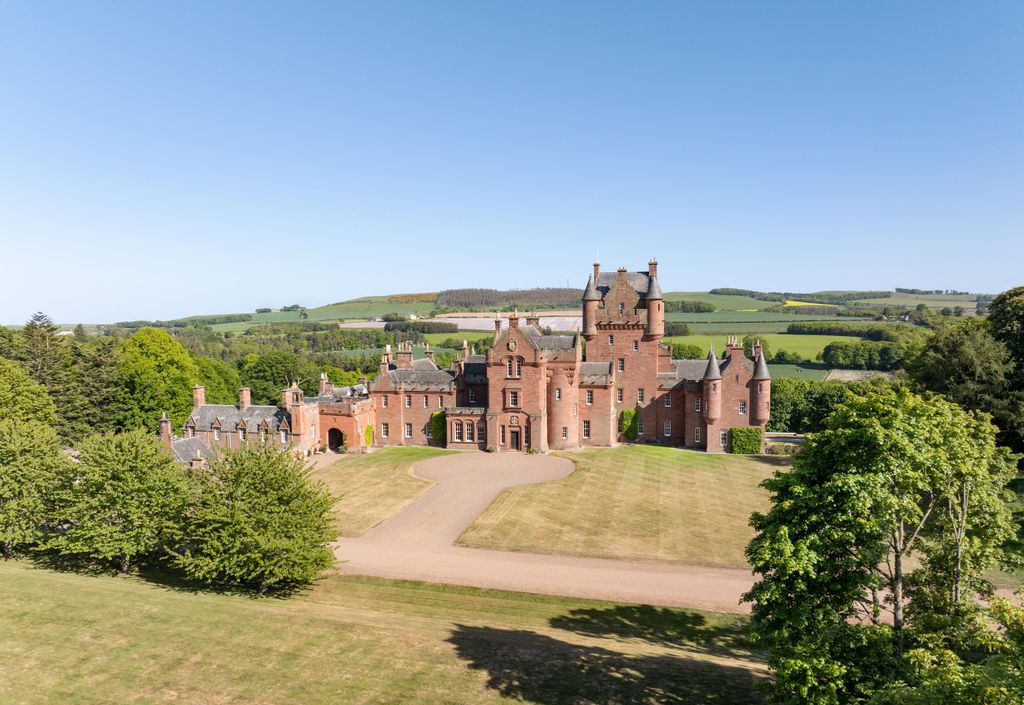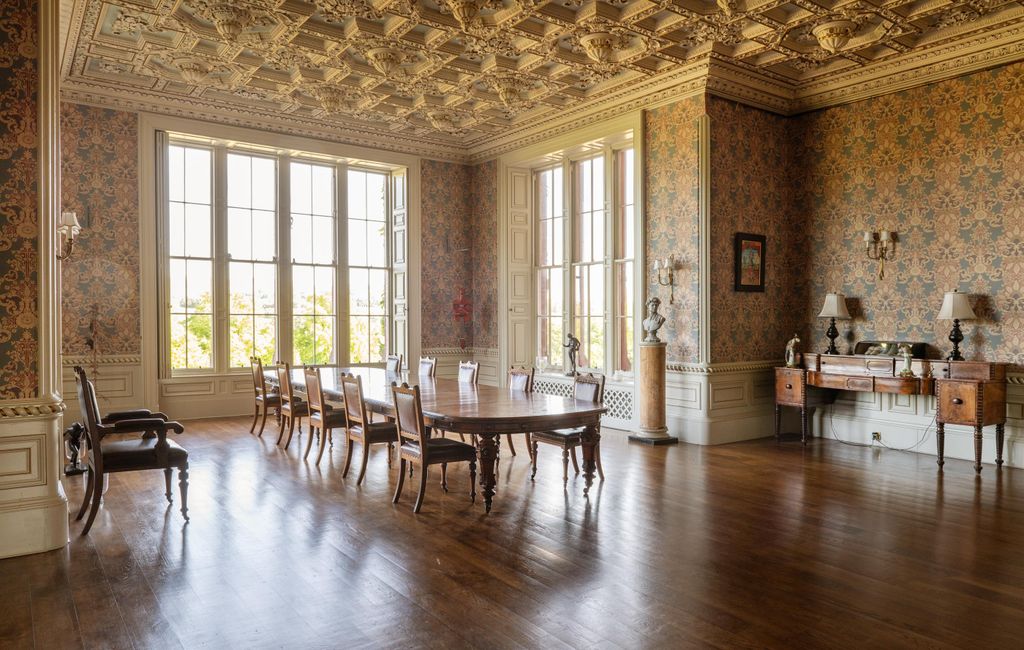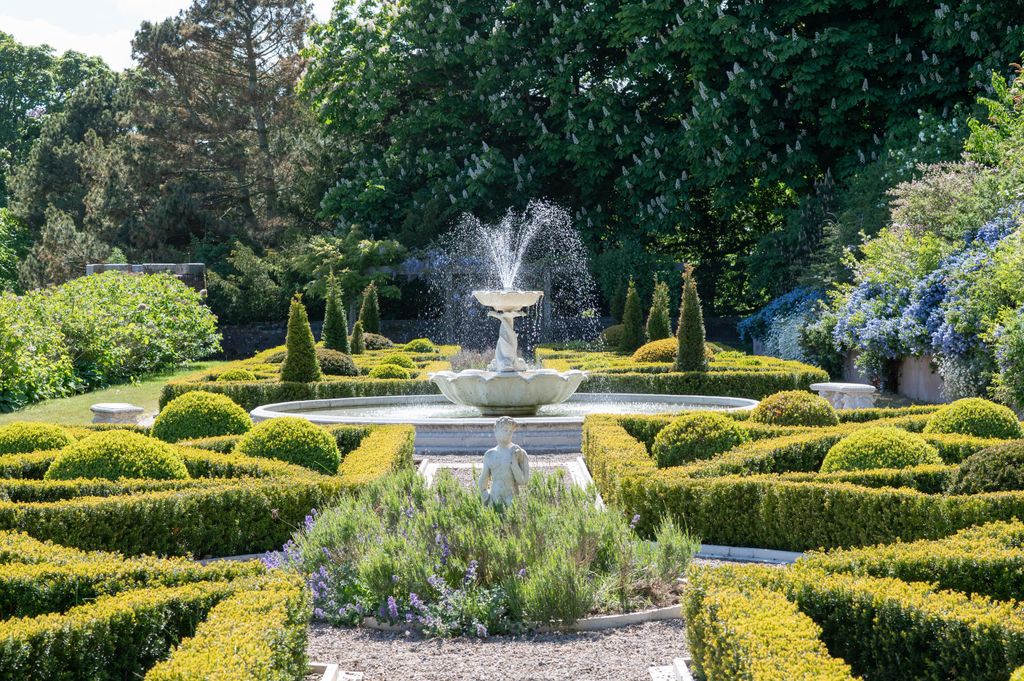Offers over
£3,250,000
(£98/sq. ft)
17 bed property for saleAyton, Berwickshire TD14
17 beds
9 baths
8 receptions
33,261 sq. ft
Freehold
About this property
17 bedrooms
8 reception rooms
9 bathrooms
160.00 acres
Outbuildings
Period
Equestrian
Fishing
Garden
Riverside
Rural
Stabling
Paddock
Standalone secondary accommodation
Staff accommodation secondary accommodation
Description
Ayton Castle is widely regarded as Scotland's finest baronial-style building and was designed by James Gillespie Graham, Scotland's leading Gothic revival architect of the early 19th century. The castle is a magnificent example of a Scots baronial house, primarily over two storeys, with a five-storey Great Tower. The castle is built of squared and snecked red sandstone with sandstone ashlar dressings, corbelled eaves with rope moulded corbelling to the turrets, crenelated parapets, crow-step gables and roll-moulded stone sills. Since the last sale in 2014, the current owners have undertaken significant improvements. These include significant building works, partial rewiring, re-plumbing and the redecoration of several of the principal rooms. They have also created a formal garden to the southern front of the house and installed a 101⁄4-inch gauge railway which winds through part of the grounds. Ayton Castle is accessed primarily via South Lodge, from where the gravel driveway winds through mature policy woodlands before opening out into a broad gravel car parking area flanked by extensive lawns adjacent to the principal entrance on the northern front. The entrance opens into the main hall with its adjacent inner hall, and from there the gallery forms a ground floor spinal corridor running from northeast to southwest to the formal reception rooms.
Beyond the formal reception rooms lies the private chapel, with its kitchenette and small dining room. The spacious main kitchen, with its adjacent butler's pantry, is conveniently situated close to the main dining room and provides easy access to the rear service entrance. The principal staircase is a broad turnpike stair rising from the gallery to the first floor, with further staircases rising to the second floor within the entrance tower and separately to the second, third, and fourth floors within the main tower. The first floor contains twelve bedrooms and six bathrooms, most of which have a predominantly south-facing aspect overlooking the gardens and parklands. There are four additional bedrooms with two bathrooms on the second floor, attractively proportioned and well suited to family life. There is an array of secondary accommodation at the lower ground floor and basement/courtyard levels, including the derelict former servants' hall, storerooms, and additional domestic quarters arranged around the service courtyard.
Secondary accomodation
There is a significant portfolio of attractive estate cottages, gate lodges and stable flats located on the estate that contribute to the income generated by the estate. These are let on Private Residential Tenancies or on Short Assured Tenancies.
Gardens and grounds
The listed gardens and policies fall within the concept of tree-gardening and extend to approximately 160.56 acres. They are managed by a woodland management plan and an integrated land management plan.
The gardens and parklands form part of a Category b-listed designed landscape incorporating the Upper and Lower Pinetums. Adjoining the southern front is the formal terraced garden with sandstone retaining walls, gravel paths, box hedges and an impressive fountain. Generous lawns frame the driveway turning circle to the north. Concealed within the grounds is a 16th century dovecote, restored in the 18th century, and a subterranean ice-house.
Stable block
The Category B listed stable block is located a short distance to the north of the castle. There is stabling for approximately nine horses, various loose boxes, several stores, a staff room, a tack room, workshop and a double garage.
Historical note
Ayton Castle is the last major work of James Gillespie Graham's leading Gothic revival architecture and was designed by him in 1845. Norman settlers were the first recorded owners of Ayton when the De Vesci family are understood to have built a small castle. Thereafter little is known until the 18th century.
Situation
Ayton Castle is situated to the northeast and approximately two miles inland from the Berwickshire coastline. Ayton is a small rural village with a village store, primary school and a pub. The A1 bypasses the village and connects with Berwick-upon-Tweed and beyond. Much of the A1 is now dual carriageway and provides a quick link to both Edinburgh and Newcastle, including their international airports and railway stations. Berwick-upon-Tweed, approximately seven miles to the east, is a stop on the main East Coast railway line and offers daily connections to both Edinburgh and London. Berwick-upon-Tweed also has a wider selection of retail outlets including several supermarkets and a good range of local facilities and services. There is good private schooling in the local area, including Longridge Towers just outside Berwick and Belhaven Preparatory School in Dunbar. Edinburgh offers a very good choice of private schools.
From a recreational perspective, there is brown trout fishing on the Eye Water which flows through the policies. The nearby River Tweed is renowned as one of Scotland's most important salmon fisheries. Challenging game shooting for pheasant, partridge and grouse is available locally, and the policies offer entertaining rough shooting, with the sporting rights included in the sale. Berwickshire and its neighbouring counties are traditionally rural, with agriculture as the dominant industry. There are regular National Hunt and flat race meetings at Kelso, Musselburgh and Hexham. Golfers have access to a wide choice of notable courses within easy reach, including Eyemouth, Goswick, Dunbar, Muirfield and the championship Roxburghe course near Kelso
Ayton Castle is widely regarded as Scotland's finest baronial-style building and was designed by James Gillespie Graham, Scotland's leading Gothic revival architect of the early 19th century. The castle is a magnificent example of a Scots baronial house, primarily over two storeys, with a five-storey Great Tower. The castle is built of squared and snecked red sandstone with sandstone ashlar dressings, corbelled eaves with rope moulded corbelling to the turrets, crenelated parapets, crow-step gables and roll-moulded stone sills. Since the last sale in 2014, the current owners have undertaken significant improvements. These include significant building works, partial rewiring, re-plumbing and the redecoration of several of the principal rooms. They have also created a formal garden to the southern front of the house and installed a 101⁄4-inch gauge railway which winds through part of the grounds. Ayton Castle is accessed primarily via South Lodge, from where the gravel driveway winds through mature policy woodlands before opening out into a broad gravel car parking area flanked by extensive lawns adjacent to the principal entrance on the northern front. The entrance opens into the main hall with its adjacent inner hall, and from there the gallery forms a ground floor spinal corridor running from northeast to southwest to the formal reception rooms.
Beyond the formal reception rooms lies the private chapel, with its kitchenette and small dining room. The spacious main kitchen, with its adjacent butler's pantry, is conveniently situated close to the main dining room and provides easy access to the rear service entrance. The principal staircase is a broad turnpike stair rising from the gallery to the first floor, with further staircases rising to the second floor within the entrance tower and separately to the second, third, and fourth floors within the main tower. The first floor contains twelve bedrooms and six bathrooms, most of which have a predominantly south-facing aspect overlooking the gardens and parklands. There are four additional bedrooms with two bathrooms on the second floor, attractively proportioned and well suited to family life. There is an array of secondary accommodation at the lower ground floor and basement/courtyard levels, including the derelict former servants' hall, storerooms, and additional domestic quarters arranged around the service courtyard.
Secondary accomodation
There is a significant portfolio of attractive estate cottages, gate lodges and stable flats located on the estate that contribute to the income generated by the estate. These are let on Private Residential Tenancies or on Short Assured Tenancies.
Gardens and grounds
The listed gardens and policies fall within the concept of tree-gardening and extend to approximately 160.56 acres. They are managed by a woodland management plan and an integrated land management plan.
The gardens and parklands form part of a Category b-listed designed landscape incorporating the Upper and Lower Pinetums. Adjoining the southern front is the formal terraced garden with sandstone retaining walls, gravel paths, box hedges and an impressive fountain. Generous lawns frame the driveway turning circle to the north. Concealed within the grounds is a 16th century dovecote, restored in the 18th century, and a subterranean ice-house.
Stable block
The Category B listed stable block is located a short distance to the north of the castle. There is stabling for approximately nine horses, various loose boxes, several stores, a staff room, a tack room, workshop and a double garage.
Historical note
Ayton Castle is the last major work of James Gillespie Graham's leading Gothic revival architecture and was designed by him in 1845. Norman settlers were the first recorded owners of Ayton when the De Vesci family are understood to have built a small castle. Thereafter little is known until the 18th century.
Situation
Ayton Castle is situated to the northeast and approximately two miles inland from the Berwickshire coastline. Ayton is a small rural village with a village store, primary school and a pub. The A1 bypasses the village and connects with Berwick-upon-Tweed and beyond. Much of the A1 is now dual carriageway and provides a quick link to both Edinburgh and Newcastle, including their international airports and railway stations. Berwick-upon-Tweed, approximately seven miles to the east, is a stop on the main East Coast railway line and offers daily connections to both Edinburgh and London. Berwick-upon-Tweed also has a wider selection of retail outlets including several supermarkets and a good range of local facilities and services. There is good private schooling in the local area, including Longridge Towers just outside Berwick and Belhaven Preparatory School in Dunbar. Edinburgh offers a very good choice of private schools.
From a recreational perspective, there is brown trout fishing on the Eye Water which flows through the policies. The nearby River Tweed is renowned as one of Scotland's most important salmon fisheries. Challenging game shooting for pheasant, partridge and grouse is available locally, and the policies offer entertaining rough shooting, with the sporting rights included in the sale. Berwickshire and its neighbouring counties are traditionally rural, with agriculture as the dominant industry. There are regular National Hunt and flat race meetings at Kelso, Musselburgh and Hexham. Golfers have access to a wide choice of notable courses within easy reach, including Eyemouth, Goswick, Dunbar, Muirfield and the championship Roxburghe course near Kelso
Mortgage calculator
Monthly repayment
£16,258 per month
Whole of market comparison
70+ lenders and 10,000+ products
The monthly repayments provided are estimates and should be used as a guide only. The actual amount you can borrow will depend on your personal financial situation and subject to a full application. For a more precise estimate, please use the Mojo mortgage calculator. Your home or property may be repossessed if you do not keep up repayments on your mortgage.




.png)